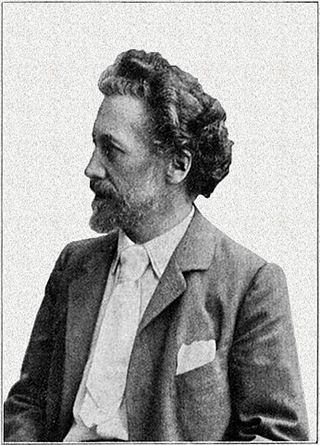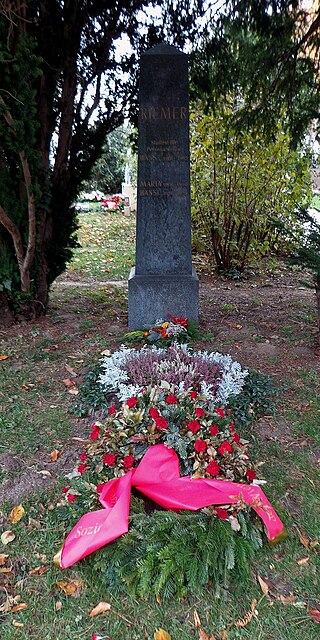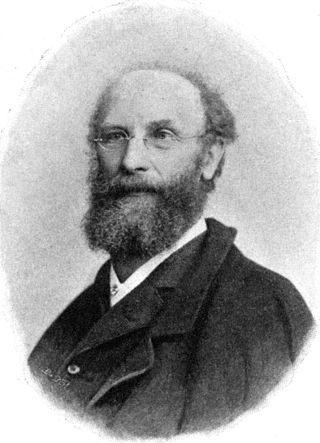

Hans Bitterlich (28 April 1860, Vienna - 5 August 1949, Vienna) was an Austrian sculptor.


Hans Bitterlich (28 April 1860, Vienna - 5 August 1949, Vienna) was an Austrian sculptor.
His father was the sculptor and history painter, Eduard Bitterlich. He studied with Edmund von Hellmer and Kaspar von Zumbusch, and was a professor at the Academy of Fine Arts, Vienna, from 1901 to 1931.
His best known works include a monument to Gutenberg in the Lugeck district (1900), and the monument to Empress Elisabeth in the Volksgarten, both with an architectural framework by Friedrich Ohmann. [1]
In 1943, he was awarded the Goethe-Medaille für Kunst und Wissenschaft, and placed on the Gottbegnadeten list of Joseph Goebbels, as an important artist of the Nazi state. [2]
He was interred in the Wiener Zentralfriedhof in a Gewidmete Gräber der Stadt Wien (Dedicated Grave). [3]

The Vienna Central Cemetery is one of the largest cemeteries in the world by number of interred, and is the most well-known cemetery among Vienna's nearly 50 cemeteries. The cemetery's name is descriptive of its significance as Vienna's biggest cemetery, not of its geographic location, as it is not in the city center of the Austrian capital, but on the southern outskirts, in the outer city district of Simmering.

Carl Heinrich Auspitz was a Jewish Austrian dermatologist. He was the husband of pianist Auguste Auspitz-Kólar (1843–1878).

Alfred Hrdlicka was an Austrian sculptor, painter, and professor. His surname is sometimes written Hrdlička.

Friedrich Achleitner was an Austrian poet and architecture critic. As a member of the Wiener Gruppe, he wrote concrete poems and experimental literature. His magnum opus is a multi-volume documentation of 20th-century Austrian architecture. Written over several decades, Achleitner made a personal visit to each building described. He was a professor of the history and theory of architecture at the University of Applied Arts Vienna.

Viktor Oskar Tilgner was an Austrian sculptor and medailleur.

The Volksgarten is a public park in the Innere Stadt first district of Vienna, Austria. The garden, which is part of the Hofburg Palace, was laid out by Ludwig Remy in 1821. The park was built over the city fortifications that were destroyed by Napoleon in 1809. The Volksgarten was opened to the public in 1823.

Franz Rumpler was an Austrian genre and landscape painter.

Edmund Ritter von Hellmer, born Edmund Hellmer and ennobled in 1912, was an Austrian sculptor who worked in the styles of Historicism and Art Nouveau.

Julius Mayreder was an Austrian architect.
Felix Imre was an Austrian soldier of the German Wehrmacht and a Resistance fighter. He was sentenced to death by Volksgerichtshof and decapitated.

Hans Riemer was an Austrian politician of the Social Democratic Party of Austria (SPÖ). From 1949 to 1956 he was a member of the Bundesrat and from 1956 to 1963 a member of the city council of Vienna.

Siegmund Eibenschütz was an Austrian theatre director and conductor.
Theophil Antonicek was an Austrian musicologist.

Karl Haffner (pseudonym), real name Karl Schlechter, was a German dramaturge.

Johann Sioly was an Austrian folksinger and Wienerlied composer.

Ludwig Karpath was an Austrian musicologist.

Charles Wilda, originally Karl was an Austrian Orientalist painter. He was the elder brother of the painter, Gottfried Wilda.

Anton Schrödl was an Austrian painter of animals and genre scenes.

Johannes Benk was an Austrian monumental sculptor.

Friedrich Ohmann was an Austrian architect in the Historicist style.